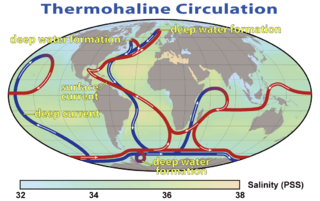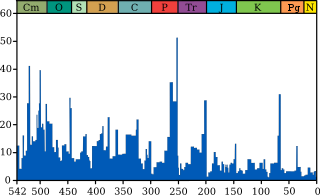This is an old revision of this page, as edited by EMsmile (talk | contribs) at 10:35, 25 June 2024 (→General: moved up a level). The present address (URL) is a permanent link to this revision, which may differ significantly from the current revision.
Revision as of 10:35, 25 June 2024 by EMsmile (talk | contribs) (→General: moved up a level)(diff) ← Previous revision | Latest revision (diff) | Newer revision → (diff) Form of climate change

An abrupt climate change occurs when the climate system is forced to transition at a rate that is determined by the climate system energy-balance. The transition rate is more rapid than the rate of change of the external forcing, though it may include sudden forcing events such as meteorite impacts. Abrupt climate change therefore is a variation beyond the variability of a climate. Past events include the end of the Carboniferous Rainforest Collapse, Younger Dryas, Dansgaard–Oeschger events, Heinrich events and possibly also the Paleocene–Eocene Thermal Maximum. The term is also used within the context of climate change to describe sudden climate change that is detectable over the time-scale of a human lifetime. Such a sudden climate change can be the result of feedback loops within the climate system or tipping points in the climate system.
Scientists may use different timescales when speaking of abrupt events. For example, the duration of the onset of the Paleocene–Eocene Thermal Maximum may have been anywhere between a few decades and several thousand years. In comparison, climate models predict that under ongoing greenhouse gas emissions, the Earth's near surface temperature could depart from the usual range of variability in the last 150 years as early as 2047.
Definitions
Abrupt climate change can be defined in terms of physics or in terms of impacts: "In terms of physics, it is a transition of the climate system into a different mode on a time scale that is faster than the responsible forcing. In terms of impacts, an abrupt change is one that takes place so rapidly and unexpectedly that human or natural systems have difficulty adapting to it. These definitions are complementary: the former gives some insight into how abrupt climate change comes about; the latter explains why there is so much research devoted to it."
Timescales
Timescales of events described as abrupt may vary dramatically. Changes recorded in the climate of Greenland at the end of the Younger Dryas, as measured by ice-cores, imply a sudden warming of +10 °C (+18 °F) within a timescale of a few years. Other abrupt changes are the +4 °C (+7.2 °F) on Greenland 11,270 years ago or the abrupt +6 °C (11 °F) warming 22,000 years ago on Antarctica.
By contrast, the Paleocene–Eocene Thermal Maximum may have initiated anywhere between a few decades and several thousand years. Finally, Earth System's models project that under ongoing greenhouse gas emissions as early as 2047, the Earth's near surface temperature could depart from the range of variability in the last 150 years.
General
Possible tipping elements in the climate system include regional effects of climate change, some of which had abrupt onset and may therefore be regarded as abrupt climate change. Scientists have stated, "Our synthesis of present knowledge suggests that a variety of tipping elements could reach their critical point within this century under anthropogenic climate change".
It has been postulated that teleconnections – oceanic and atmospheric processes on different timescales – connect both hemispheres during abrupt climate change.
A 2013 report from the U.S. National Research Council called for attention to the abrupt impacts of climate change, stating that even steady, gradual change in the physical climate system can have abrupt impacts elsewhere, such as in human infrastructure and ecosystems if critical thresholds are crossed. The report emphasizes the need for an early warning system that could help society better anticipate sudden changes and emerging impacts.
A characteristic of the abrupt climate change impacts is that they occur at a rate that is faster than anticipated. This element makes ecosystems that are immobile and limited in their capacity to respond to abrupt changes, such as forestry ecosystems, particularly vulnerable.
The probability of abrupt change for some climate related feedbacks may be low. Factors that may increase the probability of abrupt climate change include higher magnitudes of global warming, warming that occurs more rapidly and warming that is sustained over longer time periods.
Climate models
Main article: Climate modelClimate models are currently unable to predict abrupt climate change events, or most of the past abrupt climate shifts. A potential abrupt feedback due to thermokarst lake formations in the Arctic, in response to thawing permafrost soils, releasing additional greenhouse gas methane, is currently not accounted for in climate models.
Effects in the past


In the past, abrupt climate change has likely caused wide-ranging and severe effects as follows:
- Mass extinctions, most notably the Permian–Triassic extinction event (often referred colloquially to as the Great Dying) and the Carboniferous Rainforest Collapse, have been suggested as a consequence of abrupt climate change.
- Loss of biodiversity: without interference from abrupt climate change and other extinction events, the biodiversity of Earth would continue to grow.
- Changes in ocean circulation such as:
- Increasing frequency of El Niño events
- Potential disruption to the thermohaline circulation, such as that which may have occurred during the Younger Dryas event.
- Changes to the North Atlantic oscillation
- Changes in Atlantic Meridional Overturning Circulation (AMOC) which could contribute to more severe weather events.
Past events

Several periods of abrupt climate change have been identified in the paleoclimatic record. Notable examples include:
- About 25 climate shifts, called Dansgaard–Oeschger cycles, which have been identified in the ice core record during the glacial period over the past 100,000 years.
- The Younger Dryas event, notably its sudden end. It is the most recent of the Dansgaard–Oeschger cycles and began 12,900 years ago and moved back into a warm-and-wet climate regime about 11,600 years ago. It has been suggested that "the extreme rapidity of these changes in a variable that directly represents regional climate implies that the events at the end of the last glaciation may have been responses to some kind of threshold or trigger in the North Atlantic climate system." A model for this event based on disruption to the thermohaline circulation has been supported by other studies.
- The Paleocene–Eocene Thermal Maximum, timed at 55 million years ago, which may have been caused by the release of methane clathrates, although potential alternative mechanisms have been identified. This was associated with rapid ocean acidification
- The Permian–Triassic Extinction Event, in which up to 95% of all species became extinct, has been hypothesized to be related to a rapid change in global climate. Life on land took 30 million years to recover.
- The Carboniferous Rainforest Collapse occurred 300 million years ago, at which time tropical rainforests were devastated by climate change. The cooler, drier climate had a severe effect on the biodiversity of amphibians, the primary form of vertebrate life on land.
There are also abrupt climate changes associated with the catastrophic draining of glacial lakes. One example of this is the 8.2-kiloyear event, which is associated with the draining of Glacial Lake Agassiz. Another example is the Antarctic Cold Reversal, c. 14,500 years before present (BP), which is believed to have been caused by a meltwater pulse probably from either the Antarctic ice sheet or the Laurentide Ice Sheet. These rapid meltwater release events have been hypothesized as a cause for Dansgaard–Oeschger cycles,
A 2017 study concluded that similar conditions to today's Antarctic ozone hole (atmospheric circulation and hydroclimate changes), ~17,700 years ago, when stratospheric ozone depletion contributed to abrupt accelerated Southern Hemisphere deglaciation. The event coincidentally happened with an estimated 192-year series of massive volcanic eruptions, attributed to Mount Takahe in West Antarctica.
Possible precursors
Most abrupt climate shifts are likely due to sudden circulation shifts, analogous to a flood cutting a new river channel. The best-known examples are the several dozen shutdowns of the North Atlantic Ocean's Meridional Overturning Circulation during the last ice age, affecting climate worldwide.
- The current warming of the Arctic, the duration of the summer season, is considered abrupt and massive.
- Antarctic ozone depletion caused significant atmospheric circulation changes.
- There have also been two occasions when the Atlantic's Meridional Overturning Circulation lost a crucial safety factor. The Greenland Sea flushing at 75 °N shut down in 1978, recovering over the next decade. Then the second-largest flushing site, the Labrador Sea, shut down in 1997 for ten years. While shutdowns overlapping in time have not been seen during the 50 years of observation, previous total shutdowns had severe worldwide climate consequences.
Climate feedback effects

One source of abrupt climate change effects is a feedback process, in which a warming event causes a change that adds to further warming. The same can apply to cooling. Examples of such feedback processes are:
- Ice–albedo feedback in which the advance or retreat of ice cover alters the albedo ("whiteness") of the earth and its ability to absorb the sun's energy.
- Soil carbon feedback is the release of carbon from soils in response to global warming.
- The dying and the burning of forests by global warming.
Tipping points in the climate system
This section is an excerpt from Tipping points in the climate system. In climate science, a tipping point is a critical threshold that, when crossed, leads to large, accelerating and often irreversible changes in the climate system. If tipping points are crossed, they are likely to have severe impacts on human society and may accelerate global warming. Tipping behavior is found across the climate system, for example in ice sheets, mountain glaciers, circulation patterns in the ocean, in ecosystems, and the atmosphere. Examples of tipping points include thawing permafrost, which will release methane, a powerful greenhouse gas, or melting ice sheets and glaciers reducing Earth's albedo, which would warm the planet faster. Thawing permafrost is a threat multiplier because it holds roughly twice as much carbon as the amount currently circulating in the atmosphere.Volcanism
Isostatic rebound in response to glacier retreat (unloading) and increased local salinity have been attributed to increased volcanic activity at the onset of the abrupt Bølling–Allerød warming. They are associated with the interval of intense volcanic activity, hinting at an interaction between climate and volcanism: enhanced short-term melting of glaciers, possibly via albedo changes from particle fallout on glacier surfaces.
See also
References
- Harunur Rashid; Leonid Polyak; Ellen Mosley-Thompson (2011). Abrupt climate change: mechanisms, patterns, and impacts. American Geophysical Union. ISBN 9780875904849.
- Committee on Abrupt Climate Change, National Research Council. (2002). "Definition of Abrupt Climate Change". Abrupt climate change : inevitable surprises. Washington, D.C.: National Academy Press. doi:10.17226/10136. ISBN 978-0-309-07434-6.
- ^ Sahney, S.; Benton, M.J.; Falcon-Lang, H.J. (2010). "Rainforest collapse triggered Pennsylvanian tetrapod diversification in Euramerica". Geology. 38 (12): 1079–1082. Bibcode:2010Geo....38.1079S. doi:10.1130/G31182.1.
- Broecker, W. S. (May 2006). "Geology. Was the Younger Dryas triggered by a flood?". Science. 312 (5777): 1146–1148. doi:10.1126/science.1123253. ISSN 0036-8075. PMID 16728622. S2CID 39544213.
- National Research Council (2002). Abrupt climate change : inevitable surprises. Washington, D.C.: National Academy Press. p. 108. ISBN 0-309-07434-7.
- Rial, J. A.; Pielke Sr., R. A.; Beniston, M.; Claussen, M.; Canadell, J.; Cox, P.; Held, H.; De Noblet-Ducoudré, N.; Prinn, R.; Reynolds, J. F.; Salas, J. D. (2004). "Nonlinearities, Feedbacks and Critical Thresholds within the Earth's Climate System" (PDF). Climatic Change. 65: 11–00. doi:10.1023/B:CLIM.0000037493.89489.3f. hdl:11858/00-001M-0000-0013-A8E8-0. S2CID 14173232. Archived from the original (PDF) on 9 March 2013.
- ^ Mora, C (2013). "The projected timing of climate departure from recent variability". Nature. 502 (7470): 183–187. Bibcode:2013Natur.502..183M. doi:10.1038/nature12540. PMID 24108050. S2CID 4471413.
- "1: What defines "abrupt" climate change?". LAMONT-DOHERTY EARTH OBSERVATORY. Retrieved 8 July 2021.
- Grachev, A.M.; Severinghaus, J.P. (2005). "A revised +10±4 °C magnitude of the abrupt change in Greenland temperature at the Younger Dryas termination using published GISP2 gas isotope data and air thermal diffusion constants". Quaternary Science Reviews. 24 (5–6): 513–9. Bibcode:2005QSRv...24..513G. doi:10.1016/j.quascirev.2004.10.016.
- Kobashi, T.; Severinghaus, J.P.; Barnola, J. (30 April 2008). "4 ± 1.5 °C abrupt warming 11,270 yr ago identified from trapped air in Greenland ice". Earth and Planetary Science Letters. 268 (3–4): 397–407. Bibcode:2008E&PSL.268..397K. doi:10.1016/j.epsl.2008.01.032.
- Taylor, K.C.; White, J; Severinghaus, J; Brook, E; Mayewski, P; Alley, R; Steig, E; Spencer, M; Meyerson, E; Meese, D; Lamorey, G; Grachev, A; Gow, A; Barnett, B (January 2004). "Abrupt climate change around 22 ka on the Siple Coast of Antarctica". Quaternary Science Reviews. 23 (1–2): 7–15. Bibcode:2004QSRv...23....7T. doi:10.1016/j.quascirev.2003.09.004.
- ^ Lenton, T. M.; Held, H.; Kriegler, E.; Hall, J. W.; Lucht, W.; Rahmstorf, S.; Schellnhuber, H. J. (2008). "Inaugural Article: Tipping elements in the Earth's climate system". Proceedings of the National Academy of Sciences. 105 (6): 1786–1793. Bibcode:2008PNAS..105.1786L. doi:10.1073/pnas.0705414105. PMC 2538841. PMID 18258748.
- Markle; et al. (2016). "Global atmospheric teleconnections during Dansgaard–Oeschger events". Nature Geoscience. 10. Nature: 36–40. doi:10.1038/ngeo2848.
- Board on Atmospheric Sciences and Climate (2013). "Abrupt Impacts of Climate Change: Anticipating Surprises". Archived from the original on 13 October 2017. Retrieved 12 December 2013.
- Bengston, David N.; Crabtree, Jason; Hujala, Teppo (1 December 2020). "Abrupt climate change: Exploring the implications of a wild card". Futures. 124: 102641. doi:10.1016/j.futures.2020.102641. ISSN 0016-3287. S2CID 224860967.
- Clark, P.U.; et al. (December 2008). "Executive Summary". Abrupt Climate Change. A Report by the U.S. Climate Change Science Program and the Subcommittee on Global Change Research. Reston, Virginia: U.S. Geological Survey. pp. 1–7.
- ^ IPCC. "Summary for Policymakers". Sec. 2.6. The Potential for Large-Scale and Possibly Irreversible Impacts Poses Risks that have yet to be Reliably Quantified. Archived from the original on 24 September 2015. Retrieved 10 May 2018.
- ^ Mayewski, Paul Andrew (2016). "Abrupt climate change: Past, present and the search for precursors as an aid to predicting events in the future (Hans Oeschger Medal Lecture)". EGU General Assembly Conference Abstracts. 18: EPSC2016-2567. Bibcode:2016EGUGA..18.2567M.
- "Unexpected Future Boost of Methane Possible from Arctic Permafrost". NASA. 2018.
- ^ Sahney, S.; Benton, M.J. (2008). "Recovery from the most profound mass extinction of all time". Proceedings of the Royal Society B. 275 (1636): 759–65. doi:10.1098/rspb.2007.1370. PMC 2596898. PMID 18198148.
- ^ Crowley, T. J.; North, G. R. (May 1988). "Abrupt Climate Change and Extinction Events in Earth History". Science. 240 (4855): 996–1002. Bibcode:1988Sci...240..996C. doi:10.1126/science.240.4855.996. PMID 17731712. S2CID 44921662.
- Sahney, S.; Benton, M.J.; Ferry, P.A. (2010). "Links between global taxonomic diversity, ecological diversity and the expansion of vertebrates on land". Biology Letters. 6 (4): 544–547. doi:10.1098/rsbl.2009.1024. PMC 2936204. PMID 20106856.
- Trenberth, K. E.; Hoar, T. J. (1997). "El Niño and climate change". Geophysical Research Letters. 24 (23): 3057–3060. Bibcode:1997GeoRL..24.3057T. doi:10.1029/97GL03092.
- Meehl, G. A.; Washington, W. M. (1996). "El Niño-like climate change in a model with increased atmospheric CO2 concentrations". Nature. 382 (6586): 56–60. Bibcode:1996Natur.382...56M. doi:10.1038/382056a0. S2CID 4234225.
- Broecker, W. S. (1997). "Thermohaline Circulation, the Achilles Heel of Our Climate System: Will Man-Made CO2 Upset the Current Balance?" (PDF). Science. 278 (5343): 1582–1588. Bibcode:1997Sci...278.1582B. doi:10.1126/science.278.5343.1582. PMID 9374450. Archived from the original (PDF) on 22 November 2009.
- ^ Manabe, S.; Stouffer, R. J. (1995). "Simulation of abrupt climate change induced by freshwater input to the North Atlantic Ocean" (PDF). Nature. 378 (6553): 165. Bibcode:1995Natur.378..165M. doi:10.1038/378165a0. S2CID 4302999.
- Beniston, M.; Jungo, P. (2002). "Shifts in the distributions of pressure, temperature and moisture and changes in the typical weather patterns in the Alpine region in response to the behavior of the North Atlantic Oscillation" (PDF). Theoretical and Applied Climatology. 71 (1–2): 29–42. Bibcode:2002ThApC..71...29B. doi:10.1007/s704-002-8206-7. S2CID 14659582.
- J. Hansen; M. Sato; P. Hearty; R. Ruedy; et al. (2015). "Ice melt, sea level rise and superstorms: evidence from paleoclimate data, climate modeling, and modern observations that 2 °C global warming is highly dangerous". Atmospheric Chemistry and Physics Discussions. 15 (14): 20059–20179. Bibcode:2015ACPD...1520059H. doi:10.5194/acpd-15-20059-2015.
Our results at least imply that strong cooling in the North Atlantic from AMOC shutdown does create higher wind speed. * * * The increment in seasonal mean wind speed of the northeasterlies relative to preindustrial conditions is as much as 10–20%. Such a percentage increase of wind speed in a storm translates into an increase of storm power dissipation by a factor ~1.4–2, because wind power dissipation is proportional to the cube of wind speed. However, our simulated changes refer to seasonal mean winds averaged over large grid-boxes, not individual storms.* * * Many of the most memorable and devastating storms in eastern North America and western Europe, popularly known as superstorms, have been winter cyclonic storms, though sometimes occurring in late fall or early spring, that generate near-hurricane-force winds and often large amounts of snowfall. Continued warming of low latitude oceans in coming decades will provide more water vapor to strengthen such storms. If this tropical warming is combined with a cooler North Atlantic Ocean from AMOC slowdown and an increase in midlatitude eddy energy, we can anticipate more severe baroclinic storms.
- "Heinrich and Dansgaard–Oeschger Events". National Centers for Environmental Information (NCEI) formerly known as National Climatic Data Center (NCDC). NOAA. Archived from the original on 22 December 2016. Retrieved 7 August 2019.
- Alley, R. B.; Meese, D. A.; Shuman, C. A.; Gow, A. J.; Taylor, K. C.; Grootes, P. M.; White, J. W. C.; Ram, M.; Waddington, E. D.; Mayewski, P. A.; Zielinski, G. A. (1993). "Abrupt increase in Greenland snow accumulation at the end of the Younger Dryas event" (PDF). Nature. 362 (6420): 527–529. Bibcode:1993Natur.362..527A. doi:10.1038/362527a0. hdl:11603/24307. S2CID 4325976. Archived from the original (PDF) on 17 June 2010.
- Farley, K. A.; Eltgroth, S. F. (2003). "An alternative age model for the Paleocene–Eocene thermal maximum using extraterrestrial 3He". Earth and Planetary Science Letters. 208 (3–4): 135–148. Bibcode:2003E&PSL.208..135F. doi:10.1016/S0012-821X(03)00017-7.
- Pagani, M.; Caldeira, K.; Archer, D.; Zachos, C. (December 2006). "Atmosphere. An ancient carbon mystery". Science. 314 (5805): 1556–1557. doi:10.1126/science.1136110. ISSN 0036-8075. PMID 17158314. S2CID 128375931.
- Zachos, J. C.; Röhl, U.; Schellenberg, S. A.; Sluijs, A.; Hodell, D. A.; Kelly, D. C.; Thomas, E.; Nicolo, M.; Raffi, I.; Lourens, L. J.; McCarren, H.; Kroon, D. (June 2005). "Rapid acidification of the ocean during the Paleocene–Eocene thermal maximum". Science. 308 (5728): 1611–1615. Bibcode:2005Sci...308.1611Z. doi:10.1126/science.1109004. hdl:1874/385806. PMID 15947184. S2CID 26909706.
- Benton, M. J.; Twitchet, R. J. (2003). "How to kill (almost) all life: the end-Permian extinction event" (PDF). Trends in Ecology & Evolution. 18 (7): 358–365. doi:10.1016/S0169-5347(03)00093-4. Archived from the original (PDF) on 18 April 2007.
- Alley, R. B.; Mayewski, P. A.; Sowers, T.; Stuiver, M.; Taylor, K. C.; Clark, P. U. (1997). "Holocene climatic instability: A prominent, widespread event 8200 yr ago". Geology. 25 (6): 483. Bibcode:1997Geo....25..483A. doi:10.1130/0091-7613(1997)025<0483:HCIAPW>2.3.CO;2.
- Weber; Clark; Kuhn; Timmermann (5 June 2014). "Millennial-scale variability in Antarctic ice-sheet discharge during the last deglaciation". Nature. 510 (7503): 134–138. Bibcode:2014Natur.510..134W. doi:10.1038/nature13397. PMID 24870232. S2CID 205238911.
- Gregoire, Lauren (11 July 2012). "Deglacial rapid sea level rises caused by ice-sheet saddle collapses" (PDF). Nature. 487 (7406): 219–222. Bibcode:2012Natur.487..219G. doi:10.1038/nature11257. PMID 22785319. S2CID 4403135.
- Bond, G.C.; Showers, W.; Elliot, M.; Evans, M.; Lotti, R.; Hajdas, I.; Bonani, G.; Johnson, S. (1999). "The North Atlantic's 1–2 kyr climate rhythm: relation to Heinrich events, Dansgaard/Oeschger cycles and the little ice age" (PDF). In Clark, P.U.; Webb, R.S.; Keigwin, L.D. (eds.). Mechanisms of Global Change at Millennial Time Scales. Geophysical Monograph. American Geophysical Union, Washington DC. pp. 59–76. ISBN 0-87590-033-X. Archived from the original (PDF) on 29 October 2008.
- McConnell; et al. (2017). "Synchronous volcanic eruptions and abrupt climate change ~17.7 ka plausibly linked by stratospheric ozone depletion". Proceedings of the National Academy of Sciences. 114 (38). PNAS: 10035–10040. Bibcode:2017PNAS..11410035M. doi:10.1073/pnas.1705595114. PMC 5617275. PMID 28874529.
- ^ Alley, R. B.; Marotzke, J.; Nordhaus, W. D.; Overpeck, J. T.; Peteet, D. M.; Pielke Jr, R. A.; Pierrehumbert, R. T.; Rhines, P. B.; Stocker, T. F.; Talley, L. D.; Wallace, J. M. (March 2003). "Abrupt Climate Change" (PDF). Science. 299 (5615): 2005–2010. Bibcode:2003Sci...299.2005A. doi:10.1126/science.1081056. PMID 12663908. S2CID 19455675.
- Schlosser P, Bönisch G, Rhein M, Bayer R (1991). "Reduction of deepwater formation in the Greenland Sea during the 1980s: Evidence from tracer data". Science. 251 (4997): 1054–1056. Bibcode:1991Sci...251.1054S. doi:10.1126/science.251.4997.1054. PMID 17802088. S2CID 21374638.
- Rhines, P. B. (2006). "Sub-Arctic oceans and global climate". Weather. 61 (4): 109–118. Bibcode:2006Wthr...61..109R. doi:10.1256/wea.223.05.
- Våge, K.; Pickart, R. S.; Thierry, V.; Reverdin, G.; Lee, C. M.; Petrie, B.; Agnew, T. A.; Wong, A.; Ribergaard, M. H. (2008). "Surprising return of deep convection to the subpolar North Atlantic Ocean in winter 2007–2008". Nature Geoscience. 2 (1): 67. Bibcode:2009NatGe...2...67V. doi:10.1038/ngeo382. hdl:1912/2840.
- "Thermodynamics: Albedo". NSIDC.
- Lenton, Timothy M.; Rockström, Johan; Gaffney, Owen; Rahmstorf, Stefan; Richardson, Katherine; Steffen, Will; Schellnhuber, Hans Joachim (27 November 2019). "Climate tipping points – too risky to bet against". Nature. 575 (7784): 592–595. Bibcode:2019Natur.575..592L. doi:10.1038/d41586-019-03595-0. hdl:10871/40141. PMID 31776487.
- Comiso, J. C. (2002). "A rapidly declining perennial sea ice cover in the Arctic". Geophysical Research Letters. 29 (20): 17-1 – 17-4. Bibcode:2002GeoRL..29.1956C. doi:10.1029/2002GL015650.
- Malhi, Y.; Aragao, L. E. O. C.; Galbraith, D.; Huntingford, C.; Fisher, R.; Zelazowski, P.; Sitch, S.; McSweeney, C.; Meir, P. (February 2009). "Special Feature: Exploring the likelihood and mechanism of a climate-change-induced dieback of the Amazon rainforest" (PDF). PNAS. 106 (49): 20610–20615. Bibcode:2009PNAS..10620610M. doi:10.1073/pnas.0804619106. ISSN 0027-8424. PMC 2791614. PMID 19218454.
- Lenton, Tim; Rockström, Johan; Gaffney, Owen; Rahmstorf, Stefan; Richardson, Katherine; Steffen, Will; Schellnhuber, Hans Joachim (2019). "Climate tipping points – too risky to bet against". Nature. 575 (7784): 592–595. Bibcode:2019Natur.575..592L. doi:10.1038/d41586-019-03595-0. PMID 31776487.
- "Climate change driving entire planet to dangerous "global tipping point"". National Geographic. 27 November 2019. Archived from the original on 19 February 2021. Retrieved 17 July 2022.
- ^ Lenton, Tim (2021). "Tipping points in the climate system". Weather. 76 (10): 325–326. Bibcode:2021Wthr...76..325L. doi:10.1002/wea.4058. ISSN 0043-1656. S2CID 238651749.
- "The irreversible emissions of a permafrost "tipping point"". World Economic Forum. 18 February 2020. Retrieved 17 July 2022.
- Praetorius, Summer; Mix, Alan; Jensen, Britta; Froese, Duane; Milne, Glenn; Wolhowe, Matthew; Addison, Jason; Prahl, Fredrick (October 2016). "Interaction between climate, volcanism, and isostatic rebound in Southeast Alaska during the last deglaciation". Earth and Planetary Science Letters. 452: 79–89. Bibcode:2016E&PSL.452...79P. doi:10.1016/j.epsl.2016.07.033.